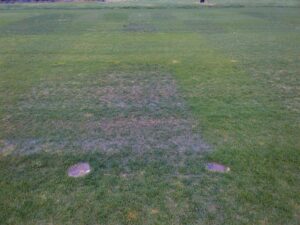Main Content
There are numerous elite varieties of Kentucky bluegrass (Compact Types) that have excellent tolerance of leaf spot, summer patch, and stripe smut diseases. Many varieties produce a very attractive, dense, compact (low growing) turf with dark green color during the summer.

However, many of these Kentucky bluegrass varieties that are grown and sold as sod have the growth characteristic of long winter dormancy and slow spring green-up. The cool dry weather of this spring has certainly exacerbated this growth response. Full green-up of these varieties typically occurs by mid- to late-May.
Practices that hasten spring green-up of turf include fertilization with moderate amounts (0.4 to 0.7 pounds per 1,000 square feet) of water soluble nitrogen (WSN) and covering the turf with a growth blanket early in the spring (March and April).
Perennial ryegrass and tall fescue will often green-up several weeks earlier than these Compact Type Kentucky bluegrasses. Perennial ryegrass typically will have the earliest green-up.
Of the fine fescues used for turf, creeping red fescue will green-up earlier than Chewings fescue and hard fescue will have the slowest spring green-up. Green-up of creeping red fescue is relatively early and not too different from perennial ryegrass.